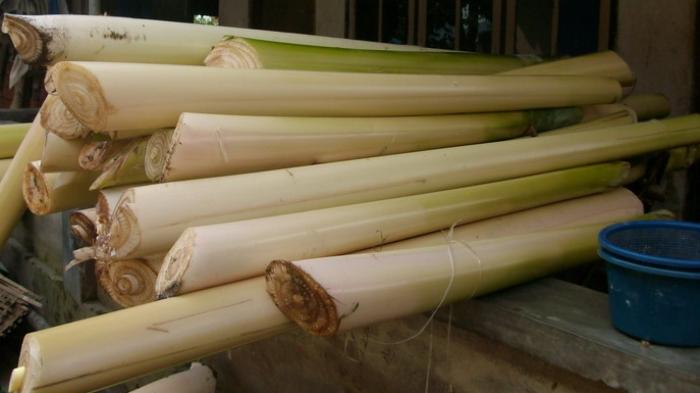According to the Central Statistics Agency (BPS), Indonesia is a tropical country that is rich in natural and cultural resources. It is an archipelago stretches in an area of 1,910,931.10 km 2, making it rich in cultures until it is well known to foreign countries. As a country that lives in the tropics, Indonesia also has medicinal plants, so many are developed as Indonesian medicinal plants (OTI).
As a medicinal plant, research evidence is needed about its usefulness and safety. The conducted scientific research is expected to produce a drug with certain standards.
Collagenase resistance of Ambon banana stem sap
The industrial era 4.0 as well as advances in science and technology, require everything instant. So does the field of health, it is expected to produce many new inexpensive drugs that can overcome the disease without causing side effects. Advances in drug manufacturing technology have led to higher drug prices. Community with lower, ability hope to get good medicine at low prices.
Indonesia as a tropical country certainly has a vast diversity of plants, ranging from ornamental plants, spices, and medicinal plants. One plant that can be used as a basic ingredient in the medicine is banana plants. Traditionally, rural people have used banana stem sap as a wound healer.
In the field of dentistry, there are many dental and oral tissue diseases. In many cases, aggressive periodontitis, toxins around the tissues are produced. So it causes tissue damage to the periodontium and alveolar bone supporting the teeth. It is indicated by the issuance of Matrix metoproteinase (MMP) cell signals that are associated with an increase of bacterial colonies such as Actinobacillus actinomycetemcomitans. Tetracycline is the right choice to inhibit MMP activity as an anti collagenase.
Banana Ambon (Musa paradisiaca var. Sapientum ) is a plant that is commonly found in Indonesia, especially in areas that get a lot of sunlight. Plants containing high concentration lectins can be used to heal wounds through the process of coagulation or the formation of blood clots. The results of the study on the administration of galectin-3 which is a lectin group showed that there was an increase in the Vascular Endothelial Growth Factor (VEGF) and Basic Fibroblast Growth Factor (b-FGF) in response to angiogenesis.
Whereas, in a previous study showed that topical administration of Ambon banana sap with doses of 30 and 60 mg in the socket area showed an increase in fibroblasts and osteoblasts by issuing PDGF-BB, BMP-4, and BMP-7 cell signals in the wound healing process of rat dental extraction. As a step to develop its usefulness, this study aims to show the role of Ambon banana stem sap through the extraction process and gel preparations, against signal release inhibition of collagen-destroying cell proteins such as MMP-2 and MMP-9 on dental extraction healing through examination tissue preparations with immunohistochemical and histological techniques.
Method and Results
This type of research is a laboratory experiment with post-test only control group design. The unit of analysis is the socket of rat’s right lower incisor which has been extracted. The sample of this study was Wistar strain male rats (Rattus novergicus ), aged three months, weighing 200 – 300 grams, healthy obtained from the Laboratory of Biochemistry, FK Universitas Airlangga. The sap can be obtained in large quantities through extraction. The result was then filtered using Whatman filter paper No. 1. The filtrate is then dried through freeze-drying. The obtained dry powder then is turned to gel with hydroxypropylmethylcellulose(HPMC) so that the active compound can easily be attached to the wound area and quickly absorbed, at a dose of 60 mg in 4% HPMC. The animals are anesthetized according to their body weight (30 mg/kg thionembutal). The extraction was done on the mandibular incisors using special pulling pliers, and the gel was applied to the extraction wound and sutured using 5-0 vicryl (Ethicon; Johnson & Johnson do Brasil, São Jose dos Campos, SP, Brazil).
Data on signal examination of collagen destroying cells, MMP-2 and MMP-9 on day 7 and 14 of healing with immunohistochemical method showed brown cells. The number of brown cells was calculated and compared between the treatment and control groups. The results of collagen destroying cells MMP-2 and MMP-9 showed a significant difference between the treatment and control groups with p
Author: Dr. Hendrik Setia Budi, drg., M.Kes
Details of this research can be viewed here:
http://www.jidmr.com/journal/wp-content/uploads/2019/07/21_D18_730_Hendrik_Setia_Budi_Layout.pdf
Hendrik Setia Budi, Eha Renwi Astuti (2019). The MMP-2, MMP-9 Expression and Collagen Density of the Ambonese Banana Stem Sap Administration on Wound Healing. J Int Dent Med Res 2019; 12(2): 492-497.





